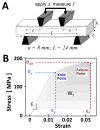Quantitative ultrashort echo time (UTE) MRI of human cortical bone: correlation with porosity and biomechanical properties
- PMID: 22190232
- PMCID: PMC3463505
- DOI: 10.1002/jbmr.1535
Quantitative ultrashort echo time (UTE) MRI of human cortical bone: correlation with porosity and biomechanical properties
Abstract
In this study we describe the use of ultrashort echo time (UTE) magnetic resonance imaging (MRI) to evaluate short and long T2* components as well as the water content of cortical bone. Fourteen human cadaveric distal femur and proximal tibia were sectioned to produce 44 rectangular slabs of cortical bone for quantitative UTE MR imaging, microcomputed tomography (µCT), and biomechanical testing. A two-dimensional (2D) UTE pulse sequence with a minimal nominal TE of 8 µseconds was used together with bicomponent analysis to quantify the bound and free water in cortical bone using a clinical 3T scanner. Total water concentration was measured using a 3D UTE sequence together with a reference water phantom. UTE MR measures of water content (total, free, and bound), T2* (short and long), and short and long T2* fractions were compared with porosity assessed with µCT, as well as elastic (modulus, yield stress, and strain) and failure (ultimate stress, failure strain, and energy) properties, using Pearson correlation. Porosity significantly correlated positively with total (R(2) = 0.23; p < 0.01) and free (R(2) = 0.31; p < 0.001) water content as well as long T2* fraction (R(2) = 0.25; p < 0.001), and negatively with short T2* fraction and short T2* (R(2) = 0.24; p < 0.01). Failure strain significantly correlated positively with short T2* (R(2) = 0.29; p < 0.001), ultimate stress significantly correlated negatively with total (R(2) = 0.25; p < 0.001) and bound (R(2) = 0.22; p < 0.01) water content, and failure energy significantly correlated positively with both short (R(2) = 0 30; p < 0.001) and long (R(2) = 0.17; p < 0.01) T2* values. These results suggest that UTE MR measures are sensitive to the structure and failure properties of human cortical bone, and may provide a novel way of evaluating cortical bone quality.
Copyright © 2012 American Society for Bone and Mineral Research.
Conflict of interest statement
All authors state that they have no conflicts of interest.
Figures





Similar articles
-
Ultrashort echo time magnetization transfer (UTE-MT) imaging of cortical bone.NMR Biomed. 2015 Jul;28(7):873-80. doi: 10.1002/nbm.3316. Epub 2015 May 18. NMR Biomed. 2015. PMID: 25981914 Free PMC article.
-
Correlations of cortical bone microstructural and mechanical properties with water proton fractions obtained from ultrashort echo time (UTE) MRI tricomponent T2* model.NMR Biomed. 2020 Mar;33(3):e4233. doi: 10.1002/nbm.4233. Epub 2019 Dec 10. NMR Biomed. 2020. PMID: 31820518 Free PMC article.
-
Magnetic resonance imaging assessed cortical porosity is highly correlated with μCT porosity.Bone. 2014 Sep;66:56-61. doi: 10.1016/j.bone.2014.06.004. Epub 2014 Jun 11. Bone. 2014. PMID: 24928498 Free PMC article.
-
An Update in Qualitative Imaging of Bone Using Ultrashort Echo Time Magnetic Resonance.Front Endocrinol (Lausanne). 2020 Sep 29;11:555756. doi: 10.3389/fendo.2020.555756. eCollection 2020. Front Endocrinol (Lausanne). 2020. PMID: 33117275 Free PMC article. Review.
-
Quantitative Ultrashort Echo Time (UTE) Magnetic Resonance Imaging of Bone: An Update.Front Endocrinol (Lausanne). 2020 Sep 18;11:567417. doi: 10.3389/fendo.2020.567417. eCollection 2020. Front Endocrinol (Lausanne). 2020. PMID: 33071975 Free PMC article. Review.
Cited by
-
3D UTE bicomponent imaging of cortical bone using a soft-hard composite pulse for excitation.Magn Reson Med. 2021 Mar;85(3):1581-1589. doi: 10.1002/mrm.28528. Epub 2020 Sep 29. Magn Reson Med. 2021. PMID: 32989787 Free PMC article.
-
Systematized water content calculation in cartilage using T1-mapping MR estimations: design and validation of a mathematical model.J Orthop Traumatol. 2017 Sep;18(3):217-220. doi: 10.1007/s10195-016-0433-8. Epub 2016 Oct 22. J Orthop Traumatol. 2017. PMID: 27771808 Free PMC article.
-
Magnetization transfer imaging of cortical bone in vivo using a zero echo time sequence in mice at 4.7 T: a feasibility study.MAGMA. 2016 Dec;29(6):853-862. doi: 10.1007/s10334-016-0577-9. Epub 2016 Jul 6. MAGMA. 2016. PMID: 27384463
-
Assessing cortical bone mechanical properties using collagen proton fraction from ultrashort echo time magnetization transfer (UTE-MT) MRI modeling.Bone Rep. 2019 Aug 2;11:100220. doi: 10.1016/j.bonr.2019.100220. eCollection 2019 Dec. Bone Rep. 2019. PMID: 31440531 Free PMC article.
-
MR-guided focused ultrasound surgery, present and future.Med Phys. 2013 Aug;40(8):080901. doi: 10.1118/1.4811136. Med Phys. 2013. PMID: 23927296 Free PMC article. Review.
References
-
- American Society for Bone and Mineral Research ASBMR Bone Curriculum. 2004 http://depts.washington.edu/bonebio/ASBMRed/ASBMRed.html.
-
- Nevitt MC, Cummings SR. Type of fall and risk of hip and wrist fractures: the study of osteoporotic fractures. The Study of Osteoporotic Fractures Research Group. J Am Geriatr Soc. 1993;41:1226–1234. - PubMed
-
- World Health Organization. WHO Technical Report Series 843. Geneva: WHO; 1994. Assessment of fracture risk and its application to screening for postmenopausal osteoporosis. - PubMed
-
- NIH consensus development panel on osteoporosis prevention, diagnosis, and therapy. JAMA. 2001;285:785–795. - PubMed
-
- Martin RB, Ishida J. The relative effects of collagen fiber orientation, porosity, density, and mineralization on bone strength. J Biomech. 1989;22:419–426. - PubMed
Publication types
MeSH terms
Grants and funding
LinkOut - more resources
Full Text Sources
Medical

